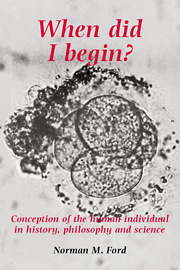Book contents
- Frontmatter
- Contents
- Foreword
- Preface
- 1 Introduction
- 2 Historical influence of Aristotle on the theory of human reproduction
- 3 Criteria for being a human individual
- 4 Fertilization and the beginning of a human individual
- 5 Implantation and the beginning of the human individual
- 6 The human individual begins after implantation
- Appendixes
- Notes
- Glossary
- Index
6 - The human individual begins after implantation
Published online by Cambridge University Press: 03 February 2010
- Frontmatter
- Contents
- Foreword
- Preface
- 1 Introduction
- 2 Historical influence of Aristotle on the theory of human reproduction
- 3 Criteria for being a human individual
- 4 Fertilization and the beginning of a human individual
- 5 Implantation and the beginning of the human individual
- 6 The human individual begins after implantation
- Appendixes
- Notes
- Glossary
- Index
Summary
Distinctive development of eutherian mammalian embryos
The use of experimental methods to increase knowledge of the early stages of eutherian mammalian development had to wait until the middle of the twentieth century. Mammals are viviparous and consequently their embryos could not survive for long outside the uterine environment until the techniques of tissue culture became available. Much progress has been made over the last 30 years. Perhaps in the future it will become possible for a mouse embryo to develop to term artificially outside the womb. For the present, early mammalian embryology might better be termed ‘pre-embryology’ since it concentrates more on the formation of the extraembryonic membranes. These develop during the preimplantation stage and provide support and nutrition for the embryo proper that is only formed subsequently. The case of amphibian embryos is quite different because they do not need extraembryonic membranes, the placenta in particular. It has been relatively easy to study their developmental stages from the start right through to term. Accordingly, it would be quite misleading to apply to the development of eutherian mammalian embryos what properly applies only to amphibian embryos.
Regionalization and symmetry begin soon after fertilization in monospermic amphibians like frogs and toads. The grey crescent appears in the animal pole opposite the point of entry of the sperm and marks the future dorsal side of the amphibian. The first cleavage is vertical and divides the egg into right and left halves. The next cleavage is at right-angles to the first and separates the ventral and dorsal halves.
- Type
- Chapter
- Information
- When Did I Begin?Conception of the Human Individual in History, Philosophy and Science, pp. 164 - 182Publisher: Cambridge University PressPrint publication year: 1988



